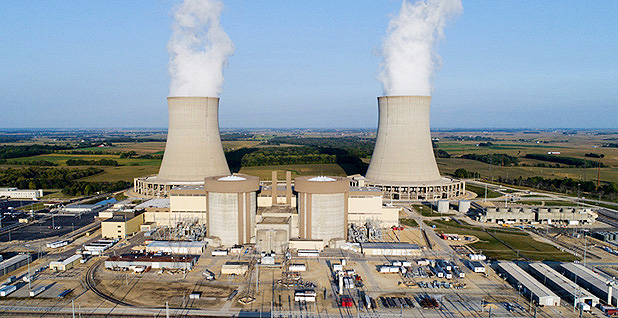Two of the state’s six nuclear plants nearly closed in 2016, but legislative action saved them. Now two more are at risk.
If there is one U.S. state you might think would be on top of the nuclear-plant-retirement problem, it’s Illinois: With 11 power reactors, more than any other state, it is number one in nuclear generating capacity. In 2019, 54 percent of its in-state generation came from nuclear power. So why, at this writing in mid-April, does Illinois still face the possibility of losing two of its nuclear plants later this year?
The Hope Creek nuclear power plant. Photo: Peretzp
New Jersey’s Board of Public Utilities (BPU) yesterday voted unanimously to extend, for an additional three years, the zero emission certificate (ZEC) program benefitting the state’s two operating nuclear power plants, Hope Creek and Salem. The two facilities produce more than 90 percent of New Jersey’s carbon-free electricity and about 40 percent of its overall power.
The CB-20 module is placed atop the Vogtle-4 containment vessel. Photo: Georgia Power
Georgia Power yesterday announced two significant milestones at the Vogtle nuclear plant’s expansion project: the commencement of hot functional testing at Unit 3 and the placement of Unit 4’s passive containment cooling water storage tank, known as CB-20.
Watts Bar nuclear power plant in Tennessee
Construction and maintenance services firm Day & Zimmermann (D&Z) has paid $200,000 to resolve allegations that it submitted false claims to the Tennessee Valley Authority for services performed in connection with capital improvement projects at the Watts Bar nuclear plant, the U.S. Attorney’s Office for the Eastern District of Tennessee announced last week.
Artist’s view of heavy water eliciting sweet taste in humans. Graphic design: Tomáš Bello/IOCB Prague
Is isotope science all sweetness and light? Recent headlines on research confirming the sweet taste of heavy water and the creation of the lightest isotope of uranium yet may give that impression. But the serious science behind these separate research findings has implications for human health and for the understanding of the process of alpha decay.
Salem Nuclear Power Plant as photographed from Delaware Bay.
When a nuclear power plant closes, here is what happens:
Thousands of people lose their jobs. The local economy nosedives. Air pollution increases. Reliance on natural gas, often bought from out-of-state, goes up. Electricity on the grid becomes less reliable with the loss of the most reliable source of power. And electric prices can even rise.
Fully ceramic microencapsulated fuel. Image: USNC
Canadian Nuclear Laboratories (CNL) announced last week that it has fabricated fully ceramic microencapsulated (FCM) fuel pellets, a proprietary reactor fuel designed by Ultra Safe Nuclear Corporation (USNC) for its Micro Modular Reactor (MMR). The FCM project, funded through the Canadian Nuclear Research Initiative (CNRI), represents the first time that tristructural isotropic (TRISO) fuel has been manufactured in Canada, according to CNL.
Alberta Premier Jason Kenney at an online event on April 14, after signing an agreement on small modular reactor development. Photo: Chris Schwarz/Government of Alberta
Alberta Premier Jason Kenney has added his signature to a memorandum of understanding on small modular reactor development that was signed in 2019 by the premiers of New Brunswick, Ontario, and Saskatchewan. Kenney signed the document last week at a virtual event that also promoted the release of Feasibility of Small Modular Reactor Development and Deployment in Canada—a study formally requested as part of the MOU.
April 16, 2021, 2:59PMUpdated April 19, 2021, 10:56AMNuclear News The Byron nuclear plant is currently slated for permanent closure in September. Photo: Exelon
A research and consulting firm hired by Illinois governor J. B. Pritzker’s administration to scrutinize the financial fitness of Exelon’s Byron and Dresden nuclear plants approves of limited state subsidies for the facilities, according to a redacted version of the firm’s report made available yesterday.
An image from a video released by INL shows MARVEL, to be installed in a concrete pit within the TREAT reactor building. Source: INL
Scientists studied the migration of six butterflies (from top left to bottom right): American Snout butterfly, Queen butterfly, Cloudless Sulphur butterfly, Empress Leilia butterfly, Variegated Fritillary butterfly, and Southern Dogface butterfly. (Composite photo: IAEA; photo credits: S. Bright, V. Charny, J. Gallagher, J. Green)
While scientists can tag migrating birds, mammals, and other animals to track their movements, the precise migration patterns of butterflies and other insects too small for tagging evaded scientists’ scrutiny for decades. That changed in 1996, when Leonard Wassenaar and Keith Hobson, working at the time as isotope scientists for Environment Canada, demonstrated that isotopic techniques could be used to determine the origin of individual monarch butterflies and deduce the species’ annual migration routes. Now, the same technique is being used to study other butterfly species.






 The decline in global carbon dioxide emissions recorded last year will not continue through 2021, a new report from the International Energy Agency concludes. Released last week,
The decline in global carbon dioxide emissions recorded last year will not continue through 2021, a new report from the International Energy Agency concludes. Released last week, 










